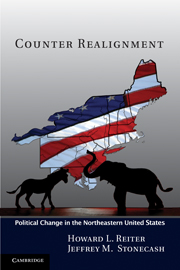Book contents
- Frontmatter
- Contents
- List of Figures
- List of Tables
- Preface
- Acknowledgments
- Postscript: Democratic Fortunes in the Northeast in 2010
- 1 Party Strategies and Transition in the Northeast
- 2 Party Pursuits and the Sources of Change
- 3 The First Republican Losses
- 4 Searching for a Majority, the Rise of Conservatives, and Second Losses
- 5 Interpreting the Goldwater Election and Pursuing the South
- 6 Social Change, Party Response, and Further Republican Losses
- 7 National Parties and the Position of the Northeast
- 8 The Process of Change and the Future
- Index
- References
3 - The First Republican Losses
Democratic Gains in the 1930s
Published online by Cambridge University Press: 05 June 2012
- Frontmatter
- Contents
- List of Figures
- List of Tables
- Preface
- Acknowledgments
- Postscript: Democratic Fortunes in the Northeast in 2010
- 1 Party Strategies and Transition in the Northeast
- 2 Party Pursuits and the Sources of Change
- 3 The First Republican Losses
- 4 Searching for a Majority, the Rise of Conservatives, and Second Losses
- 5 Interpreting the Goldwater Election and Pursuing the South
- 6 Social Change, Party Response, and Further Republican Losses
- 7 National Parties and the Position of the Northeast
- 8 The Process of Change and the Future
- Index
- References
Summary
OVERVIEW
From 1900 through 1926, Republicans dominated the Northeast. Democrats did somewhat better in 1928 in the region, and then from 1930 to 1936 they made major gains. While Democrats lost some of those gains by 1940, Republican support never returned to the level that prevailed in 1900–26. The Democratic gains of the 1930s were echoed in the rest of the nation and made the Democrats the national majority party for decades to come.
Why did this first transition occur? Much of the change is attributed to the Great Depression. Republicans were in power when it began in 1929 and in response the electorate blamed them and voted Democratic. However, this was not a simple case of economic events determining change. The transformation in the Northeast was also a product of party strategies. Parties make choices and create identities and that affects whom they attract or lose. The Northeast had undergone significant social change, becoming more urban and populated by immigrants. The Democratic Party, with some internal conflict, was trying to respond to these social trends and make inroads into the region. They had a long-term goal of bringing industrial workers, city dwellers, and immigrants and their descendants into the party. The Great Depression finally brought them those groups, but then Roosevelt had to work to retain them. The party enjoyed some modest gains among these groups even in the 1920s, but not to the level that occurred in the 1930s.
- Type
- Chapter
- Information
- Counter RealignmentPolitical Change in the Northeastern United States, pp. 32 - 54Publisher: Cambridge University PressPrint publication year: 2011



